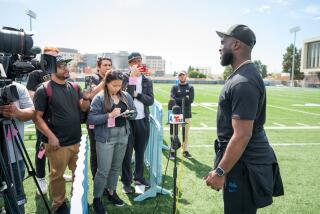If the Dodgers have, as some say,...
- Share via
If the Dodgers have, as some say, played the past couple of seasons like the walking dead, it might have something to do with their surroundings.
The stadium property once bordered the site of a Native American village and, later, one of the city’s oldest and least-known cemeteries.
The Home of Peace Cemetery, near Lookout Drive and Lilac Terrace in Chavez Ravine, is no longer a burial site; the remains of Los Angeles’ Jewish pioneers were moved to their second resting spot nearly 100 years ago. But the pioneering status of the place is honored by a plaque on the hillside--”California Registered Landmark No. 822.”
In 1850, when Los Angeles was incorporated and California was a few months away from being admitted to the Union, the new city’s streets were filled with gamblers, drunks, prostitutes and gunmen.
*
Also living in one of the meanest cities in North America were eight young Jews.
All happened to be unmarried men, and all were merchants except one, who was a tailor. They lived in four adjacent houses.
Jacob Frankfort, 40, believed to be the first Jew to arrive in Los Angeles, had come from Poland in 1841. He was joined by other young Jews from Central Europe who wanted to escape the constraints of life in Germany, Bohemia, Poland and Hungary. They were tough, self-reliant, smart and ambitious.
By 1855, there were 60 Jews living in Los Angeles. Many of them began meeting on Sunday afternoons at the Main Street home of Joseph Newmark, the city’s first lay rabbi. This group became Los Angeles’ first charity.
It was called the Hebrew Benevolent Society, known as Jewish Family Service. These volunteers provided alms for the town’s poor as well as other needy people, sending money to Chicago fire victims. They attended the sick and eventually would even pony up the cost of maintaining a cemetery.
*
But first they had to select a location where the dead could truly rest in peace amid the frenetic expansion and tumult of the infant city.
For $1, the society purchased a three-acre plot of land from the city in rugged Chavez Ravine. The property had once been an Indian village, a place where an expedition led by Gaspar de Portola camped on its historic journey from Mexico to Monterey. The land later belonged to Jose Andres Sepulveda and was used for a reservoir. That would prove to be a troublesome flaw, because in every rainy season for almost 50 years thereafter the steep and mushy grade made it difficult for the horse-drawn hearses to reach the cemetery.
Of the first 23 Jews buried in the cemetery, only three were older than 21. At the turn of the century, an increasing number of Jews began to arrive in Los Angeles, refugees from New York and Chicago seeking better air for their tuberculosis, escape from the sweatshops of the garment industry, or both.
Many of them ended up living in East Los Angeles because it was slightly higher and a bit cooler, and near their Downtown businesses. In its heyday, between 1910 and 1950, Boyle Heights was home to between 70,000 and 90,000 Jewish residents. The community built as many as 30 synagogues over a 40-year span.
As the 20th Century dawned, the cemetery property had become almost inaccessible, surrounded by oil wells, derricks, brickyards and kilns. The smoke in the area had discolored the shrubbery and blackened the monuments, a prediction of problems to come.
By 1902, the Benevolent Society had used the last of the 360 plots, and the more recent dead were buried at the new Home of Peace Cemetery at Whittier Boulevard and Eastern Avenue. Within three years, all of the original cemetery’s remains had been moved there.
Buried among some of the city’s earliest Jewish residents are Civil War veterans, members of the Benevolent Society and several of the first Jewish families that showed the city the way to its future, including the Hellmans, the Newmarks and the Cohns.
*
They were merchants, bankers, and religious and civic leaders who had contributed much to the growth of the young city. Morris L. Goodman was one of the city’s first eight councilmen, and Prussian-born Emil Harris was the only Jewish chief of police, appointed to a one-year term in 1878.
The society sold part of the old cemetery grounds back to the city, which wasted no time in digging a sewer line for a proposed quarantine house, or “pesthouse” for smallpox victims, and later for plague victims.
But as the plague waned in the 1930s, the land was abandoned and became a garbage dump.
In 1935, the city donated the site to military planners, who built one of the nation’s first and largest naval reserve armories. Jewish ownership of the remaining graveyard property, except for mineral rights, ended in 1943, when the society deeded it to the government for a housing project that never got off the ground.
*
Eventually, the U.S. government agreed to sell the land, and it came back to the city yet again. Later the city traded the property to Walter O’Malley, who made it the site of Dodger Stadium.
Today, Jewish Family Service still receives royalties of about $900 a year from its $1 cemetery investment, and members of the Jewish community like to tell visitors during bus tours how their forebears became the first Jews in Chavez Ravine.
Even before Sandy Koufax.
More to Read
Sign up for Essential California
The most important California stories and recommendations in your inbox every morning.
You may occasionally receive promotional content from the Los Angeles Times.










